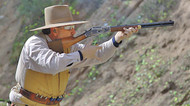Tips on How to Hold, Aim, and Shoot a Lever-Action Rifle
Posted by Taylor Caruana on Aug 3rd 2017
Ace the Lever Action: How to Hold Aim and Shoot a Lever Action Rifle
Lever guns are fast! Shooting fast impresses bystanders and can be a great skill to truly master. The Marlin rifle, despite its age, is built for speed. But how do you become quicker on a Marlin?
Here's a few fast tips to increase the pace.
STRONG SUPPORT HAND
So first things first, let's get some support! Seriously, the support hand (or off hand if you prefer) has an extremely important job. While to observers your support hand is just grasping the forend, this hand is the most responsible for the shooter's power and control over the rifle.
First, have a strong grasp, almost crush the forend grip. Remember, all the contact is in your hands and fingers. Use your large arm and shoulder muscles to really pull the gun towards you and keep it from lifting off during recoil and to keep the gun planted when the firing hand leaves the stock to swing the Marlin finger lever. You should be able to hold the rifle on target with just your support hand and firing shoulder if done correctly. Do NOT, however, lock your elbow or shoulder, this will just tire you out.
When switching from target to target, use your support hand for large movements, then your firing hand for fine and precise movements. The key is to get both arms working together. Never think your support hand is "doing nothing".
SLAP THE LEVER
So after a shot is fired, it's time to slap that lever. The best advice that I can give is to try not to overthink it. Push out as hard as you can, and let the lever be stopped mechanically, then just slam it back. Even though the finger lever moves in an arc, the motion for your hand is really more of a linear forward/back. Try to avoid short-stroking or trying to swing back before you feel a stop. A short-stroke costs a lot of time and can cause malfunctions. So just use big, powerful, almost mechanical motions. I like to push my fingers straight, and slide my trigger finger parallel with the barrel, so I can quickly get my fingers in the right place for another shot.
CONSISTENT CHEEK WELD
Keeping your cheek planted against the rear stock is one way to gain a lot of speed during splits. Using my experience, I realized that unlike a bolt-action rifle, you can have a cheek weld all throughout shooting when using a lever-action rifle. Keeping your cheek locked on lets you never lose track of your sights, and you can shoot as fast as you can stay aligned on the peep sights.
Through the recoil and lever cycling movements, I keep my cheek glued to the butt stock. This ensures speed because there is no wasted motion. Accuracy will also become more consistent, as you do not need to readjust for every shot. Remember, your support arm will keep everything locked in, allowing almost all of your decision making to go towards choosing targets, aiming, and trigger squeeze.
CORRECT POSTURE
Finally some general posture. I keep my elbows bent downward, don't chicken wings. I keep my firing hand thumb parallel with the tang so it can slip off easily. I tend to hold onto the front of the fore grip for a bit better leverage, though this is mainly preference.
Final Thoughts
While these basics might not get you cowboy action fast, they are essential building blocks. Part of the fun of off-hand shooting is wrangling your firearm and really getting the little quirks down to increase efficiency.Just remember, the shorter the lever throws, the higher the RPM. So while it's possible to be quick with a .45-70, short-stroke conversions and Levermatics are still the fastest Marlins off the line!
Frequently Asked Questions
How far can a lever-action rifle shoot?
The optimal range for a lever-action rifle while hunting is between 25 - 200 yards.
Do lever-action rifles have safeties?
When it comes to safety, lever-action rifles have a cross-bolt type safety that blocks the hammer, while most 30-30 cartridges are loaded with round-nose or flat-nose bullets for safety.
How does a lever-action rifle work?
The lever action has a large metal lever located behind the trigger along with a trigger guard, and it cycles the loading, firing, and unloading process.

